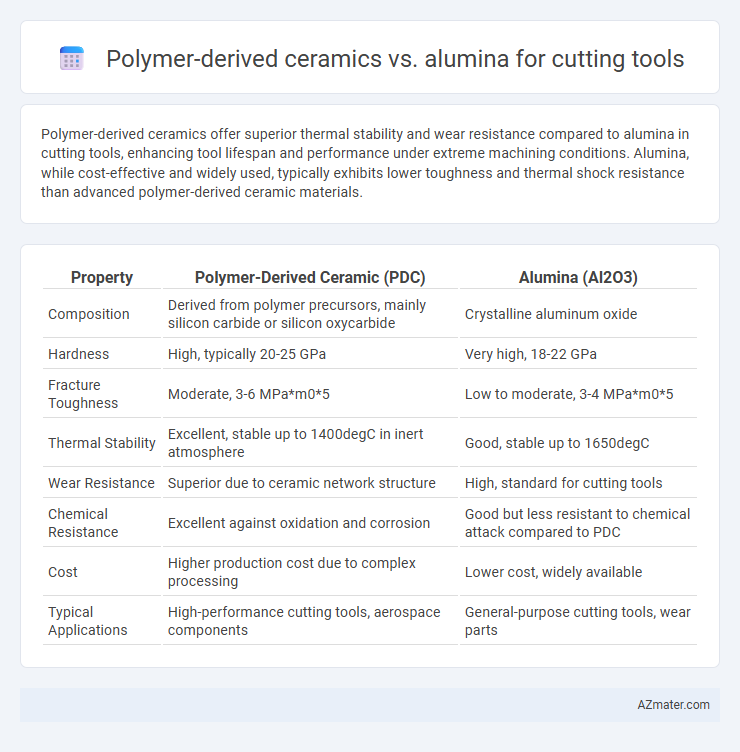Polymer-derived ceramics offer superior thermal stability and wear resistance compared to alumina in cutting tools, enhancing tool lifespan and performance under extreme machining conditions. Alumina, while cost-effective and widely used, typically exhibits lower toughness and thermal shock resistance than advanced polymer-derived ceramic materials.
Table of Comparison
| Property | Polymer-Derived Ceramic (PDC) | Alumina (Al2O3) |
|---|---|---|
| Composition | Derived from polymer precursors, mainly silicon carbide or silicon oxycarbide | Crystalline aluminum oxide |
| Hardness | High, typically 20-25 GPa | Very high, 18-22 GPa |
| Fracture Toughness | Moderate, 3-6 MPa*m0*5 | Low to moderate, 3-4 MPa*m0*5 |
| Thermal Stability | Excellent, stable up to 1400degC in inert atmosphere | Good, stable up to 1650degC |
| Wear Resistance | Superior due to ceramic network structure | High, standard for cutting tools |
| Chemical Resistance | Excellent against oxidation and corrosion | Good but less resistant to chemical attack compared to PDC |
| Cost | Higher production cost due to complex processing | Lower cost, widely available |
| Typical Applications | High-performance cutting tools, aerospace components | General-purpose cutting tools, wear parts |
Introduction to Cutting Tool Materials
Polymer-derived ceramics (PDCs) offer enhanced thermal stability and wear resistance compared to traditional alumina-based cutting tools, making them ideal for high-speed machining applications. Alumina, known for its hardness and chemical inertness, remains popular for general-purpose cutting due to its cost-effectiveness and ease of manufacture. Advances in PDC technology provide superior toughness and oxidation resistance, enabling improved tool life and performance in demanding environments.
Overview of Polymer-Derived Ceramics
Polymer-derived ceramics (PDCs) offer exceptional hardness and thermal stability compared to conventional alumina, making them highly suitable for cutting tool applications. These ceramics are synthesized from preceramic polymers that transform into dense, amorphous ceramic materials upon pyrolysis, exhibiting superior wear resistance and fracture toughness. Unlike alumina, PDCs maintain structural integrity at elevated temperatures, enhancing tool life and performance in high-speed machining environments.
Properties and Composition of Alumina
Alumina, primarily composed of aluminum oxide (Al2O3), exhibits high hardness, excellent thermal stability, and outstanding wear resistance, making it a preferred material for cutting tools. Polymer-derived ceramics, although versatile with tunable microstructures, generally have lower hardness and thermal conductivity compared to alumina. The intrinsic properties of alumina, including its exceptional oxidation resistance and high melting point, contribute to superior cutting performance and tool longevity under extreme machining conditions.
Mechanical Strength Comparison
Polymer-derived ceramics (PDCs) exhibit superior mechanical strength compared to conventional alumina in cutting tool applications, offering higher fracture toughness and enhanced hardness due to their dense amorphous or nanocrystalline microstructures. Alumina, while having excellent hardness and thermal stability, typically presents lower fracture toughness, making it more susceptible to chipping under high-stress cutting conditions. The enhanced mechanical resilience of PDCs allows for extended tool life and improved performance in machining hard or abrasive materials.
Wear Resistance Analysis
Polymer-derived ceramics (PDCs) exhibit superior wear resistance compared to alumina in cutting tool applications due to their unique microstructure and enhanced toughness. The intrinsic nanocrystalline and amorphous phases in PDCs reduce crack propagation and improve thermal stability, leading to longer tool life under high-stress conditions. Alumina, while harder, tends to suffer from brittleness and micro-fracturing, resulting in faster wear rates during intensive machining processes.
Thermal Stability and Conductivity
Polymer-derived ceramics (PDCs) exhibit superior thermal stability compared to alumina, maintaining structural integrity at temperatures exceeding 1600degC, whereas alumina typically degrades above 1200degC. The thermal conductivity of PDCs ranges between 20-30 W/m*K, which is moderate but often optimized through composite formulations, while alumina's conductivity is lower, around 10-30 W/m*K, limiting its heat dissipation efficiency during high-speed cutting. Enhanced thermal stability and adequate conductivity make polymer-derived ceramics ideal for cutting tools that require resistance to thermal shock and sustained performance under extreme machining temperatures.
Machining Performance in Industrial Applications
Polymer-derived ceramics (PDCs) exhibit superior thermal stability and wear resistance compared to alumina in cutting tool applications, enabling prolonged tool life and enhanced machining precision in industrial environments. PDCs maintain hardness at elevated temperatures, reducing tool deformation and minimizing downtime during high-speed machining of tough materials such as titanium and hardened steels. Alumina tools, while cost-effective and widely available, typically demonstrate lower fracture toughness and accelerated wear under extreme cutting conditions, limiting their efficiency in high-performance machining tasks.
Cost Effectiveness and Manufacturing Methods
Polymer-derived ceramics offer cost-effective manufacturing through lower-temperature processing and near-net-shape fabrication, reducing machining time and material waste compared to alumina, which requires high-temperature sintering and extensive machining. The versatility of polymer-derived ceramics enables complex geometries and faster production cycles, enhancing overall cost efficiency for cutting tool applications. While alumina provides high hardness and wear resistance, the reduced production costs and customization potential of polymer-derived ceramics make them increasingly attractive in cost-sensitive manufacturing environments.
Environmental and Sustainability Factors
Polymer-derived ceramics (PDCs) offer superior environmental benefits over traditional alumina cutting tools due to their lower energy consumption during manufacturing and enhanced durability, which extends tool life and reduces waste. The synthesis of PDCs involves less raw material extraction and emits fewer greenhouse gases compared to alumina production, contributing to overall sustainability. Their higher thermal and oxidation resistance allows for reduced coolant use, minimizing chemical discharge and environmental contamination in machining processes.
Future Trends in Cutting Tool Materials
Polymer-derived ceramics (PDCs) offer superior thermal stability and oxidation resistance compared to traditional alumina, enabling cutting tools to maintain hardness at higher temperatures and extend tool life in aggressive machining environments. Emerging trends emphasize the integration of PDCs with nanostructured composites to enhance fracture toughness and wear resistance, addressing limitations seen in alumina-based tools. Future cutting tool materials will likely leverage the unique chemical versatility of polymer-derived ceramics combined with advanced manufacturing techniques such as additive manufacturing and laser sintering to produce tools with tailored microstructures for specific industrial applications.

Infographic: Polymer-derived ceramic vs Alumina for Cutting tool
 azmater.com
azmater.com